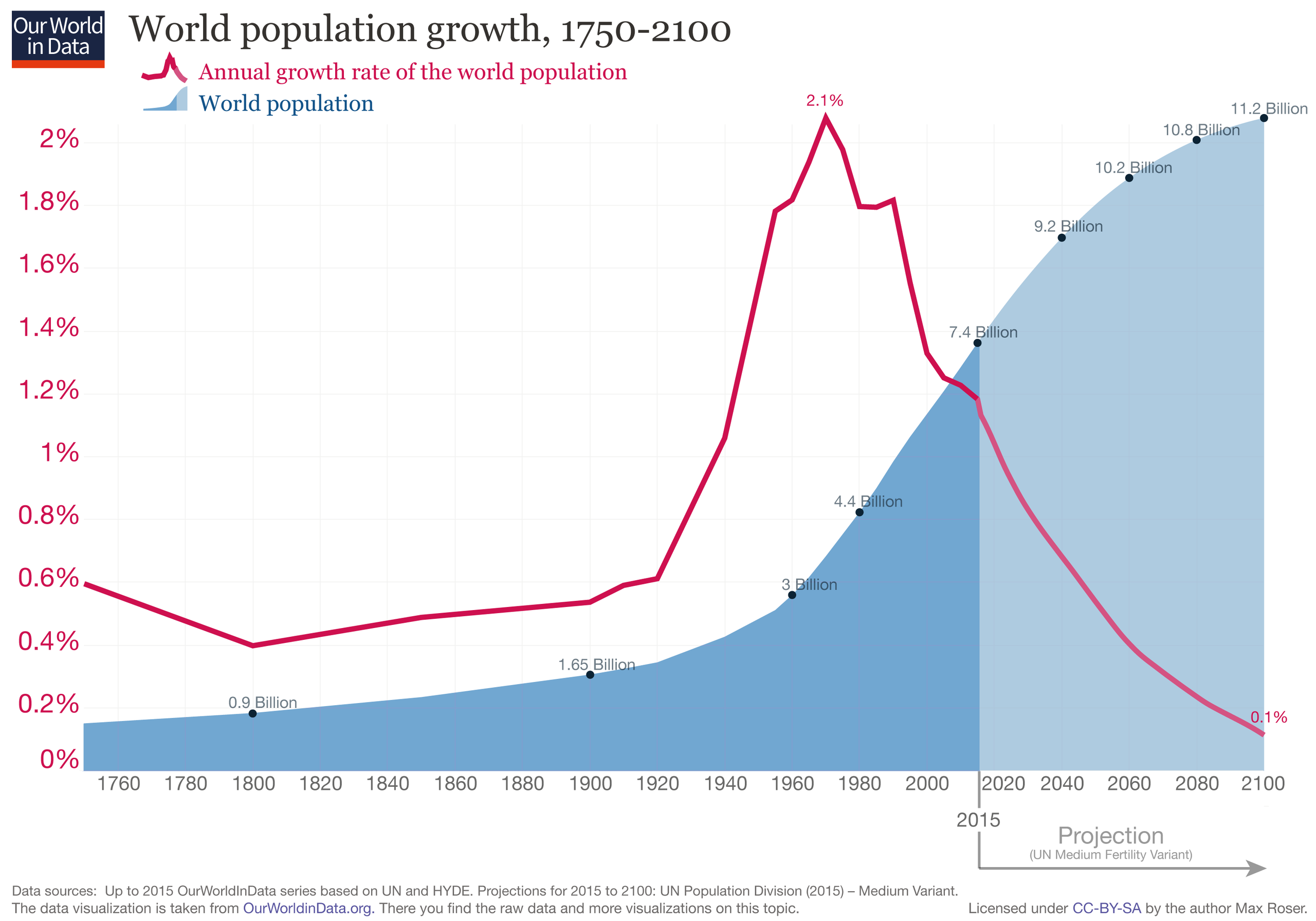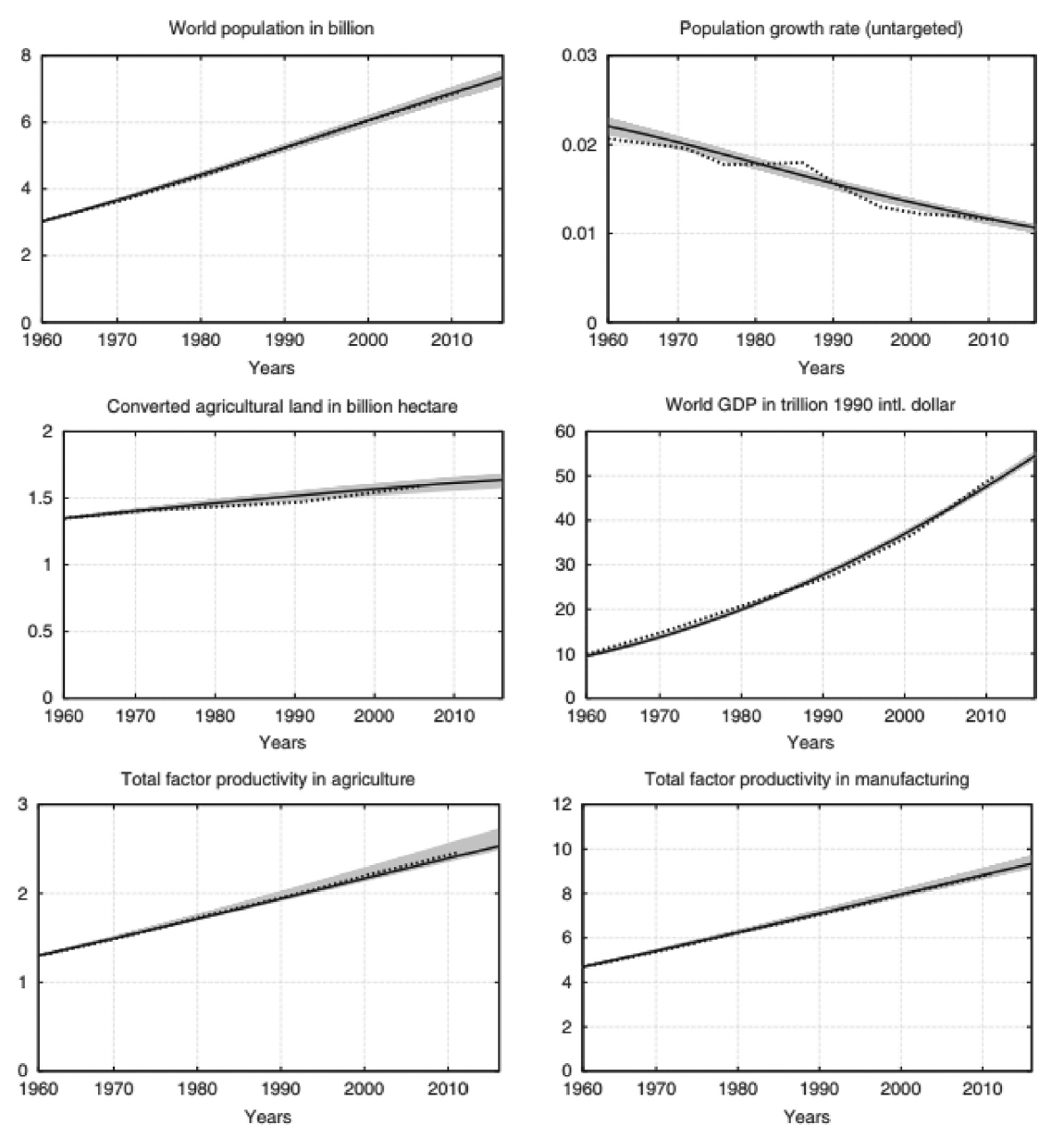The global economy is going to pass through a severe population problem over the coming century, resulting from the simultaneous peak in global population levels with near-zero population growth (Roser et al. 2013, Giovanni and Tena Junguito 2023). This conflation of world firsts is seen in Figure 1, which shows that global population is projected to reach a peak of approximately 11 billion individuals in the year 2100, at the same time that population growth is forecast to be moving asymptotically to zero.
Figure 1 World population growth, 1750-2100
The important consequence of this coincidence is the comparative inversion of the population pyramid, as the incoming cohorts of young people progressively diminish relative to the size of previous cohorts. The impact of the inversion is captured in the concept of an increasing ‘dependency rate’: the proportion of the population over 70 years of age relative to the working population. Over the past half-century, this proportion of dependents to workers stayed below 10%; in future, it will grow to 30%.
This is seen in Table 1, in which the UN projects global dependency rates rising to previously unseen levels (UN 2015). It is remarkable how stable the dependency rate has been over the past half-century, fostered by ongoing growth in population in many parts of the world. The precipitous decline in global population growth since the 1960s reverses this outcome, with sub-Saharan Africa and South Asia the only regions of the world forecast to avoid rapidly declining population growth rates in the near future. In certain parts of the more developed world, the dependency rate is forecast to approach 40–50% (Aidt and Swanson 2020). What does this change portend for the world’s resources? What are the important changes in store for the world economy?
Table 1 UN dependency rate forecasts
In a set of recent papers, we and our co-authors have been investigating the potential consequences of this demographic inversion in regard to its impact on global resource scarcity, using the case study of land scarcity for agriculture as our context (Lanz et al. 2017, Naso et al. 2020, Naso et al. 2022). Malthus of course hypothesised in the 19th century that demographic factors would drive future food scarcity. More recent hypothesises suggest that the silver-lining of this reversal in population growth might be a new era of reduced pressure on global resources. In our series of papers, we investigate this hypothesis in the context of an integrated assessment model combining and integrating the growth in land use, food consumption, population growth, technology, and standard economic production. We find that there is good reason to be concerned about how population growth interacts with resource pressure.
Our MAVA model builds on the endogenous growth models of Galor (2011), and integrated assessment models such as Nordhaus and Boyer (2003), but focuses on issues of food and resource (land) use together with those of population, production, and technology. In the MAVA model, the use of land, labour, and capital is necessary to produce the food by which the population is sustained; the resulting labour pool is then allocated across six sectors (agriculture, production, education, land maintenance, and R&D). The combination of these six sectors produces an integrated production model that is then fit to observed variables over a 50-year timespan, 1960–2010. The model’s fit to historical data (see Figure 2) demonstrates that all of these observables have moved together relatively smoothly over these five decades.
Figure 2
Interestingly, the most notable difference between the performance of these sectors over these five decades lies in the decreasing rate of resource use (i.e. land in agricultural production) relative to the expansion in the global population. Although population increased by a factor of three (from about 2.5 to 7.5 billion) over this 50-year period, the amount of land in use in agriculture increased by only about 10% (from about 1.4 to 1.6 billion km2). The reason that food and population could grow at such a rate while the growth in land use slowed lies in the growth in total factor productivity in agriculture, which increased by a factor of more than two.
We deduce from this that the main reason that Malthus’ prediction of population-driven food scarcity has proved inaccurate in the past is the fact of technological change in agriculture, which enabled technology to substitute for resources. In the case of agriculture, it is estimated that there is a fixed stock of about 2.1 billion hectares of arable land on earth, so the rapid population expansion over the two centuries since Malthus’ prediction incentivised the substitution of labour-based methods of production for these fixed resources. The agricultural R&D sector would have been one of the labour-based sectors that was so incentivised.
We can envision how this resource-augmenting process might have played out if population growth had not begun to slow in the 1960s. In Figure 3, we see that the forecasted increase in land use in the 21st century would be about 10% compared to a near 100% increase in global population. Although technological innovation becomes increasingly costly to produce in our model, the R&D sector continues to generate resource-augmenting technical change into the future, assuming the demographic structure remained constant.
Figure 3
So, how does a resource problem arise when we assume increased dependency rates? It arises because the decline in population growth is indicative of a general decline in growth across the economy. As in all endogenous growth models, MAVA’s forecasts are particularly driven by the increasing cost of children’s education, the impact of this cost on population growth, and its implied increase in dependency rates (altogether labelled the ‘demographic transition’). But when the population sector is integrated with other sectors of the economy (as in MAVA), this demographic transition is seen within a gradual slowdown in growth across all major parts of the global economy: food, land use, capital, consumption, and productivity (Figure 4). The entire system is moving in a very different direction than in the past, as observed across the economy in the years since 1960 (Maestes et. al. 2023).
Figure 4
What does this change in direction imply for resource scarcity? Resource scarcity has been less of an issue over the past two centuries of population growth due to the increasing prevalence of labour and the relative low cost of education-enabled R&D-based production methods. A future with a high cost of education and resultant lower growth in the work force implies revisiting those choices regarding the preferred methods of production, relying less on labour-based R&D and more on resources. The future goes back.
How this occurs may be seen in the MAVA forecast set out in Figure 5, in which the economy’s labour market allocation is simulated under conditions of both the long-standing dependency rate (i.e. about 7%), and the now increasing rates (i.e. towards 30%) set out in Table 1. The shifting out of the dashed lines in Figure 5 demonstrate the sectors in which greater labour allocations occur, principally in agriculture, agricultural R&D, and increased land use. The labour share in the remainder of the economy remains relatively unchanged (general R&D) or falls somewhat (education). These changes in the economy demonstrate how the economy is shifting away from its previous reliance on R&D in advancing growth in production, and back towards the natural resources on which it once relied.
Figure 5
In Figure 6, the striking impact of increased dependency is summarised: it shows that the main effect of increased dependency is an increase in the relative resource intensity of the economy with little impact on the economy otherwise. At base, all of these phenomena are being driven generally by the coming era of increased dependency rates. But the specific consequence of this change is a relative shift in emphasis away from technology-based production methods and towards more resource-based methods of production. Hence, increased resource scarcity will turn out to be a consequence of lower rates of population growth rather than higher levels of population.
Figure 6
In short, the coming century contains a population problem that should be of great concern because of the ongoing momentum that will cause global population to crest just as global population growth hits its nadir. This means that the resource scarcity problem foreseen by Malthus will become most severe just as the technological solutions provided in the past become most costly to produce. Ironically, the population problem foreseen by Malthus is one where declining population growth rates may be the primary reason for substantial increases in global resource scarcity.
Authors note: The authors wish to thank the André and Rosalie Hoffmann Foundation for their long-running support of this work, and the MAVA Foundation for its role in administering the Human Niche project. We also wish to thank the long list of co-authors, collaborators and colleagues on the project over the past dozen years, who receive individual notice in the authors lists and acknowledgements in our papers listed below.
References
Aidt, T and T Swanson (2020), “An Introduction to the economics of Malthusianism”, European Economic Review 129, 103546.
Federico, G and A Tena Junguito (2023), “How many people on earth? World population 1800–1938”, VoxEU.org, 20 February.
Galor, O (2011), Unified growth theory, Princeton University Press.
Lanz, B, S Dietz and T Swanson (2017), “Global population growth, technology, and Malthusian constraints: a quantitative growth theoretic perspective”, International Economic Review 58(3): 973–1006.
Maestes, N, K Mullen and D Powell (2023), “The Effect of Population Aging on Economic Growth, the Labour Force and Productivity”, American Economic Journal: Macroeconomics 15(2): 306–332.
Naso, P, B Lanz and T Swanson (2020), “The return of Malthus? Resource constraints in an era of declining population growth”, European Economic Review 128, 103499.
Naso, P, O Haznedar, B Lanz and T Swanson (2022), “A macroeconomic approach to global land use policy”, Resource and Energy Economics, 69, 101302.
Nordhaus, W D and J Boyer (2003), Warming the world: economic models of global warming, MIT Press.
United Nations (2015), “World Population Forecast, Department of Economic and Social Affairs Population Division”.
Roser, M, H Ritchie, E Ortiz-Ospina and L Rodés-Guirao (2013), "World Population Growth", OurWorldInData.org.









